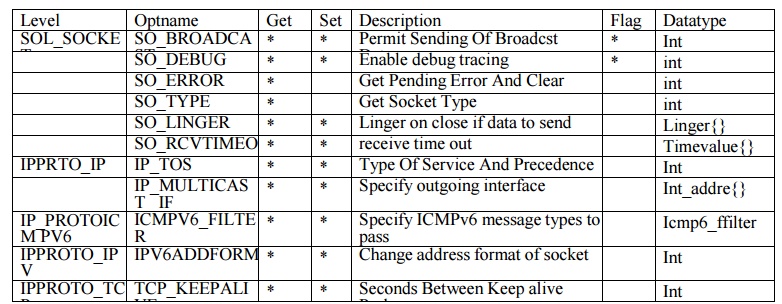Chapter: Network Programming and Management : Socket Options, Elementary UDP SOC Sockets
Socket Options
SOCKET OPTIONS
There
are a number of options like – send buffer size, bypass table look up, get
socket type, to name a few - that needs to be set. Also these needs to be got
back also. Towards realizing this, there are ways to get and set socket
options. These are:
•
The getsockopt and setsockopt functions
•
The fcntl functions and
•
The ioctl functions
The options are different for IPv4, IPv6, TCP
and for generic categories. These options are briefly discussed in this
chapter.
Fcntl is the Posix way to set a socket for non blocking I/O, signal
driven I/O and to set the owner of a
socket. Ioctl is similar to fcntl but also has added functionalities that are
not defined in the fcntl.
The syntax for the getsockopt and setsockopt is
givenbelow:
#include <sys / socket.h>
int getsockopt( int sockfd, int level, int optname, void *optval,
socklen_t, *optlen);
int setsockopt( int sockfd, int level, int
optname, const void *optval, socklen_t, *optlen); both return : 0 if OK –1 on error.
The
sockfd refers to an open socket descriptor. The level specifies the code in the
system to interpret the option. The general socket code, or some protocol
specific (IPv4 or IPv6 or TCP etc) The optval is a pointer to a variable from
which the new value of the option is fetched by setsockopt, or into which the
current value of the option is stored by the getsockopt. The size of this
variable is pecified by the final argument, as a value result for getsockopt.
The list
of options that can be set and get by the socket options are listed in the fig
7.1 (page 179.) These options, in additions being classified based on the
protocol, they are classified as either binary options (shown as flags) that
enable or disable a certain features and other options that fetch and return
specific values that we can either set or examine.
[Here are the functions for examining and
modifying socket options. They are declared in sys/socket.h.
— Function: int getsockopt (int socket, int level, int optname, void *optval,
socklen_t *optlen-ptr)
The getsockopt function gets information about
the value of option optname at level level for socket socket.
The option value is stored in a buffer that
optval points to. Before the call, you should supply in *optlen-ptr the size of
this buffer; on return, it contains the number of bytes of information actually
stored in the buffer.
Most options interpret the optval buffer as a
single intvalue.
The actual return value of getsockoptis 0on
success and -1on failure. The following errnoerror conditions are defined:
EBADF
The socket argument is not a valid file
descriptor.
ENOTSOCK
The descriptor socket is not a socket.
ENOPROTOOPT
The optname doesn't make sense for the given
level.
Function: int setsockopt (int socket, int
level, int optname, void *optval, socklen_t optlen)
This function is used to set the socket option
optname at level level for socket socket. The value of the option is passed in
the buffer optval of size optlen. ]
The data type column shows the data types of
what the optval pointer must point to for each option. The two braces notation
{} is used to indicate a structure.
There are two basic types of options : binary
options that enables or disables a certain features (flag), and options that
fetch and return specific values that we can either set or examine values. The
column labeled ―flag‖ specifies if the option is a flag option. When calling
getsockopt for these flag options, optval is an integer. The value returned in
optval is zero if the option is disabled, or nonzero if the options is enabled.
Similarly, setsocket requires a nonzero optval to turn the options on and a
zero value to turn the option off. If the flag column does not contain a * then
the options is to turn the options is used to pass a value of the specified
datatype between user process and the system.

The code in 7.2, 7.3 and 7.4 provides a method to to find out if the given option is supported and if so to print the default value.
Related Topics